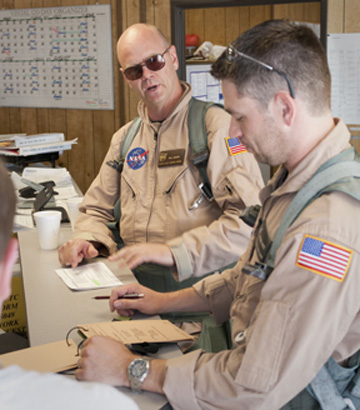By Mike Holtz
NASA Project Lead, Operations/Flight Test Engineer
Weather was on the warm side as we prepared for another mission in NASA F/A-18 #852 testing the Mars Science Laboratory landing radar, but it was still a great day to go flying. 
After intensive and lengthy ground operations on the order of an hour in the aircraft, we taxied out for our flight. We climbed up to 48,000 feet altitude and lined up for the first series of dives. We flew dive angles at 20, 30, 45 and 60 degrees.
Image right: NASA research pilot Nils Larson, left, and Mike Holtz review flight test cards before a test mission in an F/A-18.
The MSL radar within the QTEP – Quick Test Experimental Pod – was set to run several different gimbal angles, some locked and some actively slewing, all with the intent of radiating off the lakebed in some combination with the dive angles from the F-18. All but one test point on the flight cards was achieved before we hit our “bingo,” or minimal fuel remaining, and we had to land. The radar was developed by NASA’s Jet Propulsion Laboratory, and the JPL engineers were very happy with the flight. The radar engineers said the data looked fantastic.
A very good mission, plus I’m pretty sure I lost 5 pounds sweating in the cockpit!


